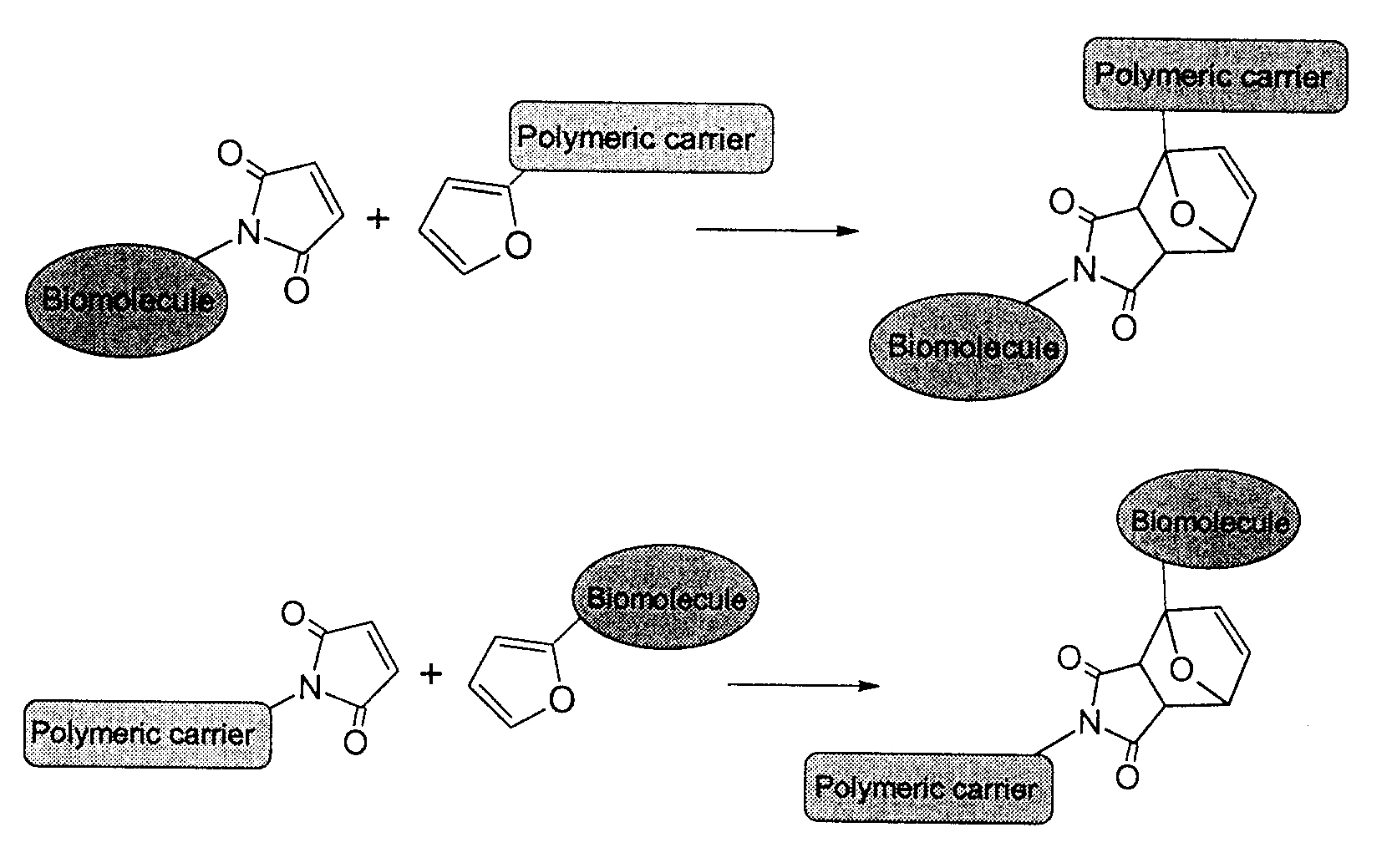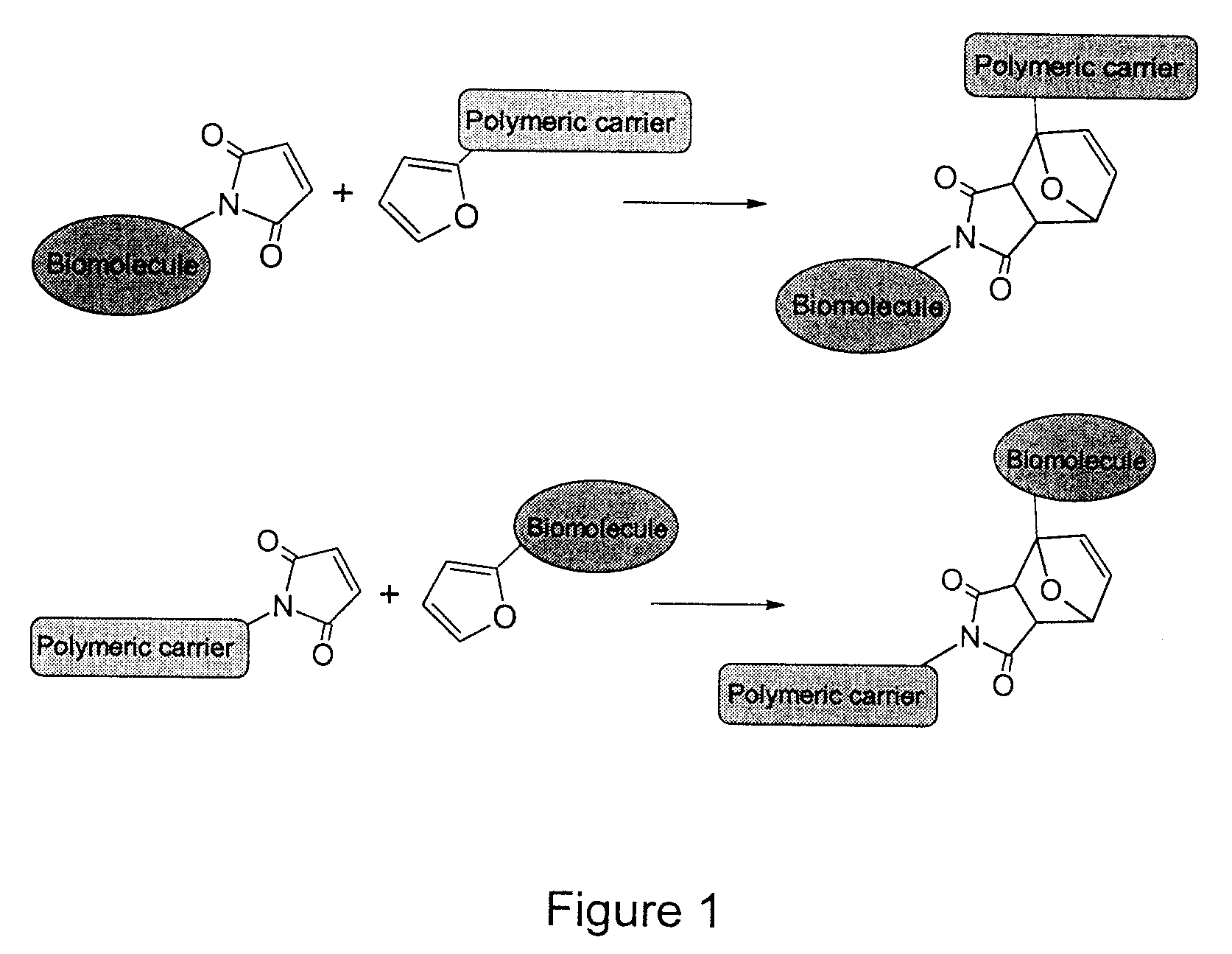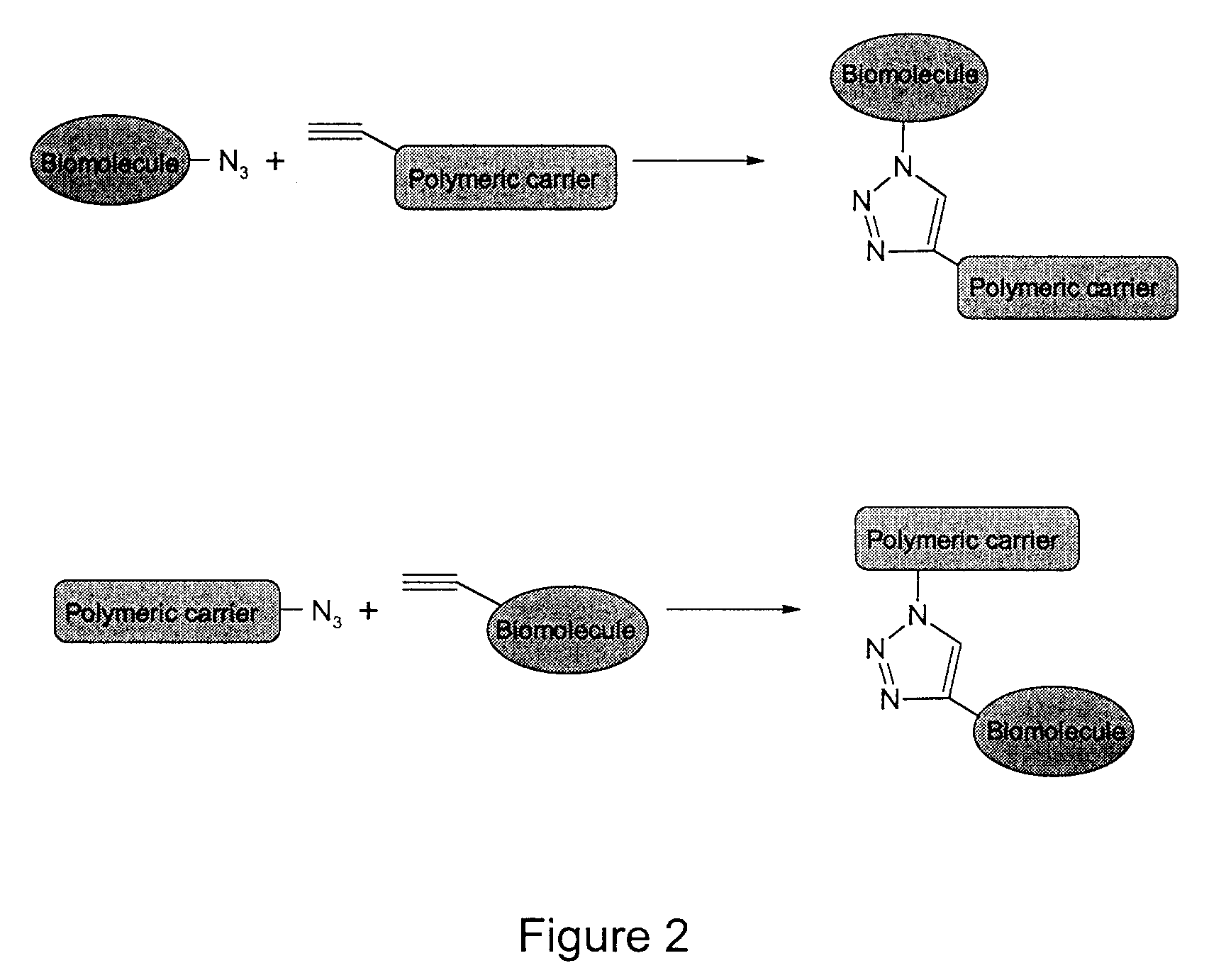Method of biomolecule immobilization on polymers using click-type chemistry
a biomolecule and click-type technology, applied in the field of biotechnology, can solve the problems of low immobilization efficiency and limited traditional immobilization methods, and achieve the effects of high efficiency, free of side products, and environmentally friendly
- Summary
- Abstract
- Description
- Claims
- Application Information
AI Technical Summary
Benefits of technology
Problems solved by technology
Method used
Image
Examples
example 1
Synthesis of Functionalized Biodegradable Polymers
[0071]The amphiphilic biodegradable copolymer, poly(2-methyl-2-carboxytrimethylene carbonate-co-D,L-lactide)-graft-poly(ethylene glycol)-furan (poly(TMCC-co-LA)-g-PEG-furan) 1, comprising a hydrophobic backbone of poly(TMCC-co-LA) and a hydrophilic graft of furan-terminated PEG, was synthesized as shown in FIG. 3 and FIG. 4. The carboxylic acid group of 2,2-bis(hydroxymethyl)propionic acid was protected by a benzyl group to yield benzyl 2,2-bis(hydroxymethyl)propionate, which was then condensed with ethyl chloroformate to form a cyclic carbonate monomer 5-methyl-5-benzyloxycarbonyl-1,3-dioxan-2-one. The resulting cyclic carbonate monomer was co-polymerized with D,L-lactide by ring-opening polymerization with tin octanoate in a bulk melt to produce the benzyl-protected poly(TMCC-co-LA). The benzyl group was removed, yielding native poly(TMCC-co-LA). 1H NMR (CDCl3, 300 MHz): δ 1.20-1.30 ppm (bm, CH3 protons of the TMC segments), 1.35-1...
example 2
Preparation of Nanoparticles
[0078]Self-aggregated nanoparticles from copolymers 1 (FIG. 4) were prepared by a dialysis process. Briefly, 5 mg / ml poly(TMCC-co-LA)-g-PEG-furan copolymer solution in dimethyl sulfoxide (DMSO) / borate buffer (90:10 vol. %) was dialyzed against distilled water using a dialysis membrane with a molecular weight cut-off (MWCO) of 12-14 kg / mol at room temperature (RT) for 24 h. The distilled water was replaced every two hours for the first 8 h. The resulting particle solution was centrifuged at 4000 rpm for 5 min to remove the aggregates. The characterization of the nanoparticles is shown in Table 4 and FIGS. 9 to 11.
[0079]
TABLE 4The effective diameters of self-aggregated nanoparticlesEffective diameters in various aqueous environmentseffective diameter(nm) (polydispersity*)pH 7.4pH 6.8Nanoparticle(PBS buffer(HEPES buffersamples10 mM)10 mM)Distilled waterNP-1-a149.7 (0.201)48.7 (0.005)43.9 (0.152)NP-1-b246.5 (0.029)42.8 (0.163)38.2 (0.005)NP-1-c346.0 (0.261)44...
example 3
Modification of Biomolecules
[0085]Maleimide-modified rabbit anti-bovine IgG antibody 4 (Mal-Ab) was prepared by oxidation of polysaccharide residues on the Fc portion with sodium periodate followed by conjugation with maleimide-containing molecule 4-(4-N-maleimidophenyl)butyric acid hydrazide (MPBH) (Hermanson, G. T. Bioconjugate techniques. Academic Press, c1996, 235-237). 100 μl of sodium periodate solution (0.1 M in 100 mM acetate buffer of pH 5.5) was added into 0.5 ml of antibody solution (2.0 mg / ml in distilled water). The reaction solution was protected from light and incubated at RT for 30 min. The oxidized antibody was purified immediately by passing the reaction solution through a Sephadex G-25 column with 100 mM acetate buffer of pH 5.5. The concentration of oxidized antibody was determined by UV-VIS spectrometer. MPBH solution (5 mg / ml in DMSO) was added slowly into the oxidized antibody solution at a 20-times molar excess. The reaction solution was incubated at RT for 2...
PUM
| Property | Measurement | Unit |
|---|---|---|
| size | aaaaa | aaaaa |
| temperatures | aaaaa | aaaaa |
| size | aaaaa | aaaaa |
Abstract
Description
Claims
Application Information
 Login to View More
Login to View More - R&D
- Intellectual Property
- Life Sciences
- Materials
- Tech Scout
- Unparalleled Data Quality
- Higher Quality Content
- 60% Fewer Hallucinations
Browse by: Latest US Patents, China's latest patents, Technical Efficacy Thesaurus, Application Domain, Technology Topic, Popular Technical Reports.
© 2025 PatSnap. All rights reserved.Legal|Privacy policy|Modern Slavery Act Transparency Statement|Sitemap|About US| Contact US: help@patsnap.com



